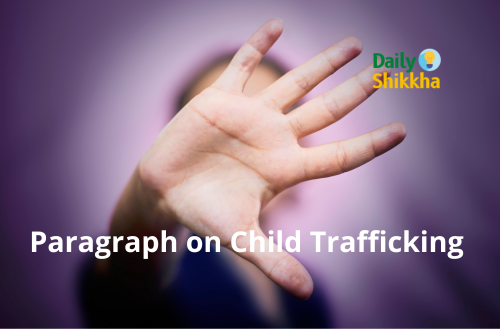The following is a concise Paragraph on Child Trafficking. It is crucial to grasp word meanings and understand the material for effective memory retention and meaningful learning. Simply memorizing without understanding may impede true comprehension. So, make an effort to understand the context of the content you are reading.
Paragraph on Child Trafficking
Child trafficking is a heinous and pervasive crime that involves the recruitment, transportation, transfer, harboring, or receipt of children for exploitative purposes. This abhorrent practice affects millions of children worldwide, depriving them of their basic human rights, dignity, and a chance for a normal childhood. Child traffickers prey on vulnerable children, often from impoverished backgrounds or broken families, and subject them to unimaginable horrors, including forced labor, sexual exploitation, child soldiering, domestic servitude, and organ trafficking.
One of the main factors contributing to the prevalence of child trafficking is poverty. Children from impoverished families are often targeted by traffickers, who lure them with false promises of a better life and opportunities for education and employment. In their desperate circumstances, families may unknowingly or willingly sell their children to traffickers, believing they are providing them with a chance to escape poverty and improve their lives. However, the reality is far from what is promised, as these children often find themselves trapped in a cycle of exploitation and abuse.
Another significant factor contributing to child trafficking is the lack of education and awareness in vulnerable communities. Many families are unaware of the dangers of child trafficking and may not recognize the signs of potential exploitation. Illiteracy and limited access to information further exacerbate the problem, making it difficult for families to make informed decisions to protect their children. Education and awareness campaigns are essential in empowering communities to recognize the risks and protect their children from falling victim to traffickers.
Conflicts and humanitarian crises also create fertile ground for child trafficking to thrive. In regions affected by armed conflicts, children are especially vulnerable to abduction and recruitment as child soldiers or forced laborers. Displaced and vulnerable populations in refugee camps and conflict zones are at heightened risk of falling prey to traffickers, who take advantage of the chaos and lack of oversight.
Gender discrimination is another critical aspect to consider when addressing child trafficking. Girls are disproportionately affected by trafficking and are often forced into sexual exploitation and domestic servitude. Boys, on the other hand, may be targeted for forced labor, including in hazardous industries such as mining, agriculture, and construction. Tackling gender inequality and empowering girls and boys alike is essential in breaking the cycle of exploitation and trafficking.
Child trafficking is not limited to a particular region or country; it is a global issue that requires international cooperation and coordination to combat effectively. Trafficking networks often operate across borders, making it challenging to track and apprehend traffickers. International collaboration is crucial in sharing intelligence, conducting joint investigations, and prosecuting offenders. Moreover, countries must strengthen their legal frameworks and enforce stringent anti-trafficking laws to hold perpetrators accountable and provide justice for victims.
Rescue and rehabilitation of trafficking victims are paramount in breaking the cycle of exploitation and helping children recover from their traumatic experiences. Safe and secure shelters, counseling, medical care, and educational support are essential in restoring the physical and emotional well-being of survivors. Reintegration into society requires comprehensive support and the removal of stigmas associated with being a trafficking victim.
Prevention is key in combating child trafficking. Governments, NGOs, and community organizations must work together to address the root causes of trafficking and protect vulnerable children. Poverty alleviation programs, access to quality education, and social support services are crucial in reducing the vulnerability of children to traffickers. Communities must be educated about the dangers of trafficking and empowered to report suspicious activities and protect their children from exploitation.
Furthermore, efforts should be made to disrupt the demand for goods and services produced through child labor and exploitation. Consumers can play a role in promoting ethical practices by supporting companies and products with transparent and ethical supply chains. Governments can also implement measures to ensure companies adhere to ethical standards and do not contribute to the demand for products produced by exploited children.
Educational institutions, including schools and universities, play a crucial role in raising awareness about child trafficking among students. Integrating age-appropriate curricula that address human rights, child protection, and trafficking prevention can equip students with the knowledge and empathy needed to make a difference. Teachers and educators can engage students in discussions, workshops, and awareness campaigns to instill a sense of responsibility and empathy toward the plight of trafficked children.
Read More Paragraph: Paragraph on Dangers of Smoking for SSC And HSC
In conclusion, child trafficking is a grave violation of children’s rights and a global crisis that demands urgent action. The exploitation and abuse suffered by trafficked children are unconscionable, and it is incumbent upon governments, civil society, and individuals to work together to eradicate this scourge from our world. By addressing the root causes, raising awareness, implementing robust legal frameworks, and providing support and rehabilitation to victims, we can create a safer and more compassionate world for all children. Let us unite in our efforts to protect the innocence and dignity of every child and ensure that they have the opportunity to thrive in a safe and nurturing environment.

